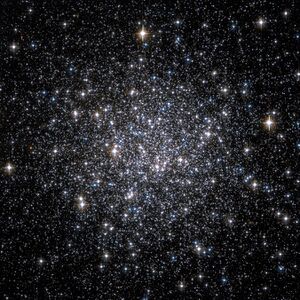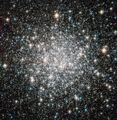Astronomy:Messier 68
| Messier 68 | |
|---|---|
 M68 from Hubble Space Telescope in 2008; 3.32′ view | |
| Observation data (J2000 epoch) | |
| Class | X[1] |
| Constellation | Hydra |
| Right ascension | 12h 39m 27.98s[2] |
| Declination | –26° 44′ 38.6″[2] |
| Distance | 33.6 kly (10.3 kpc)[3] |
| Apparent magnitude (V) | 7.8[4] |
| Apparent dimensions (V) | 11.0′ |
| Physical characteristics | |
| Mass | 2.23×105[3] M☉ |
| Radius | 53 ly[5] |
| Metallicity | [math]\displaystyle{ \begin{smallmatrix}\left[\ce{Fe}/\ce{H}\right]\end{smallmatrix} }[/math] = –2.23[3] dex |
| Estimated age | 11.2 Gyr[6] |
| Notable features | Relatively metal poor.[3] |
| Other designations | M68, NGC 4590, GCl 20[7] |
Messier 68 (also known as M68 or NGC 4590) is a globular cluster found in the east south-east of Hydra, away from its precisely equatorial part. It was discovered by Charles Messier in 1780. William Herschel described it as "a beautiful cluster of stars, extremely rich, and so compressed that most of the stars are blended together". His son John noted that it was "all clearly resolved into stars of 12th magnitude, very loose and ragged at the borders".[8]
M68 is centred about 33,600 light-years away from Earth. It is orbiting our galaxy's galactic bulge with a great eccentricity of 0.5. This takes it to 100,000 light years from the center.[8] It is one of the most metal-poor globular clusters, which means it has a paucity of elements other than hydrogen and helium. The cluster may be undergoing core-collapse, and it displays signs of being in rotation. The cluster may have been acquired in its gravitational tie to the Milky Way through accretion from a satellite galaxy.[9]
As of 2015, 50 variable stars have been identified in this cluster; the first 28 being identified as early as 1919–20 by American astronomer Harlow Shapley. Most of the variables are of type RR Lyrae, or periodic variables. Six of the variables are of the SX Phoenicis variety, which display short pulsating behavior.[9]
Gallery
See also
References
- ↑ Shapley, Harlow; Sawyer, Helen B. (August 1927), "A Classification of Globular Clusters", Harvard College Observatory Bulletin 849 (849): 11–14, Bibcode: 1927BHarO.849...11S
- ↑ 2.0 2.1 Goldsbury, Ryan et al. (December 2010), "The ACS Survey of Galactic Globular Clusters. X. New Determinations of Centers for 65 Clusters", The Astronomical Journal 140 (6): 1830–1837, doi:10.1088/0004-6256/140/6/1830, Bibcode: 2010AJ....140.1830G
- ↑ 3.0 3.1 3.2 3.3 Boyles, J. et al. (November 2011), "Young Radio Pulsars in Galactic Globular Clusters", The Astrophysical Journal 742 (1): 51, doi:10.1088/0004-637X/742/1/51, Bibcode: 2011ApJ...742...51B
- ↑ "Messier 68". https://messier.seds.org/m/m068.html.
- ↑ distance × sin( diameter_angle / 2 ) = 53 ly. radius
- ↑ Sollima, A. et al. (April 2008), "The correlation between blue straggler and binary fractions in the core of Galactic globular clusters", Astronomy and Astrophysics 481 (3): 701–704, doi:10.1051/0004-6361:20079082, Bibcode: 2008A&A...481..701S
- ↑ "M 68". SIMBAD. Centre de données astronomiques de Strasbourg. http://simbad.u-strasbg.fr/simbad/sim-basic?Ident=M+68.
- ↑ 8.0 8.1 Stoyan, Ronald; Binnewies, Stefan; Friedrich, Susanne (2008), Atlas of the Messier Objects: Highlights of the Deep Sky, Publisher Cambridge University Press, p. 826, ISBN 978-1-139-47311-8, https://books.google.com/books?id=x2VuBAAAQBAJ&pg=PT826
- ↑ 9.0 9.1 Kains, N.; Alsubai, K. A. (June 2015), "A census of variability in globular cluster M 68 (NGC 4590)", Astronomy & Astrophysics 578: 23, doi:10.1051/0004-6361/201424600, A128, Bibcode: 2015A&A...578A.128K
External links
- Globular Cluster M68 @ SEDS Messier pages
- Messier 68, Galactic Globular Clusters Database page
- Messier 68 on WikiSky: DSS2, SDSS, GALEX, IRAS, Hydrogen α, X-Ray, Astrophoto, Sky Map, Articles and images
Coordinates: ![]() 12h 39m 28.01s, −26° 44′ 34.9″
12h 39m 28.01s, −26° 44′ 34.9″
 |



